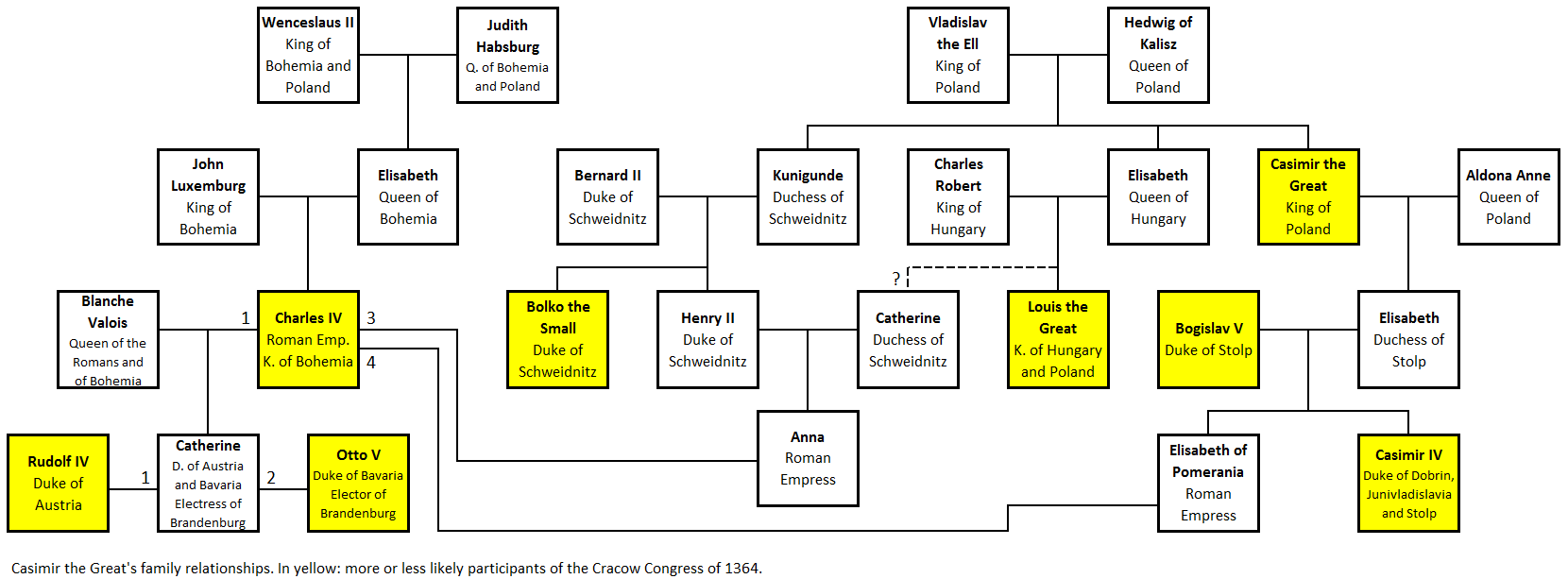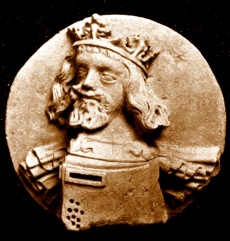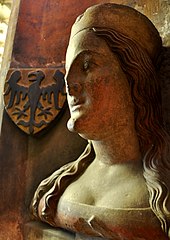A Royal Banquet in Cracow

Among many tourist attractions in my beautiful hometown of Cracow (or Kraków, if you will), the former seat of the kings of Poland, there are two venerable establishments which pride themselves on dating back to the reign of King Casimir the Great -- specifically, to the year 1364. One of them is Poland's oldest institution of higher learning, the one where Copernicus went to college. King Casimir obtained papal consent to open a university in Cracow in 1364 indeed. But it took him three more years to actually open the Academy of Cracow, and three years after that King Casimir died and the Acedemy closed for business. It was only in 1400 that King Vladislav Jagailo and Queen Hewdig founded a new university in Cracow, which is known to this day as Jagiellonian University (and not Casimirian University). "Founded in 1364" turns out to be somewhat of a stretch.
Okay, but what does it have to do with culinary history? Nothing. That's why we're now going to focus on the other establishment, one which even has the year 1364 written into its logo. Here's what we can read about it in 1,000 Places to See Before You Die, a snobbish guidebook to the world's most overpriced hotels, restaurants and other tourist traps:
| Also on the square is the historic restaurant Wierzynek, the best place to enjoy courtly European service and traditional Polish specialties. Said to be one of the oldest operating restaurants in Europe, its history goes back to 1364, when inkeeper Mikolaj Wierzynek created a banquet served on gold and silver plates for the guests of King Casimir the Great, including Holy Roman Emperor Charles IV. Wierzynek restaurant has hosted every visiting head of state ever since. Experience 500 years of history at the elegant café downstairs or the venerable upstairs salon, where seasonal game, mountains trout, and mushroom-sauced delights are served amid decorative reminders of the establishment's gloried past. |
| — Patricia Schultz: 1,000 Places to See Before You Die: A Traveler's Lifelist, New York: Workman Publishing, 2003, p. 300 |
As a child, I too was convinced that this restaurant -- back then passing for the best in town, if not in all Poland (largely due to the lack of competition) -- had been founded in 1364 by Mikołaj Wierzynek (pronounced mee-KAW-wye vyeh-ZHIH-neck), who must have been, therefore, Poland's first restaurateur. My first doubts appeared when I read that restaurants in general are a 19th-century invention and that medieval monarchs avoided dining in taverns or inns, unless they had absolutely no choice. And together with doubts came questions: What was this banquet in Cracow about? Who took part in it and why? What kind of food was served? Who was this Wierzynek and what role did he serve in the banquet? And when was the restaurant bearing his name and located at Europe's largest city square really opened?
These are the questions I'm going to try and answer today.
A Diplomatic Summit or a Family Reunion?
The only historical source that mentions the banquet at Wierzynek's are the Annals of the Glorious Kingdom of Poland by Jan Długosz, also known by his Latinized name, Joannes Longinus. According to his account, the whole story started when Charles of Luxembourg, emperor of the Holy Roman Empire and king of Bohemia (a kingdom roughly corresponding to the modern-day Czech Republic) was receiving envoys from Hungary and said something very offensive about King Louis of Hungary's mom. It led, obviously, to a major diplomatic crisis. Louis, together with Duke Rudolph Habsburg of Austria (who also had his differences with the emperor and, incidentally, his father-in-law), was getting ready for war. This is when Pope Urban V decided it was enough that Western Europe, recently ravaged by a pandemic of bubonic plague, was already being plunged into a bloody conflict (which would later come to be known as the Hundred Years' War). Having rulers of the relatively stable and quickly developing Central Europe at each other's throats would be too much. Which is why he dispatched his nuncio, Peter of Volterra, to try and calm them down. The nuncio did a great job -- he managed to prevent hostilities and to convince the wrangling monarchs to settle their argument through arbitration. It was agreed there would be two adjudicators: one was Duke Bolko the Small of Schweidnitz, the last sovereign ruler in Silesia and uncle of the emperor's recently deceased third wife. The other was King Casimir of Poland, brother of the Hungarian queen mother whose honour had been besmirched.
The nuncio also engaged in matchmaking and arranged the marriage of the recently widowed emperor with Casimir's granddaughter, Duchess Elizabeth of Stolp, Pomerania. The wedding was held in Cracow. According to Longinus, people invited by King Casimir included -- apart from the young bride (and her family) and the not-so-young groom (and his family) -- King Louis of Hungary, King Sigismund of Denmark, King Peter of Cyprus, Duke Bolko the Small of Schweidnitz, Duke Otto V of Bavaria, Duke Semovit of Masovia, Duke Vladislav II of Opole etc. The wedding reception lasted twenty days, during which barrels of wine were put out in the streets for the common folk, while the royals and lords enjoyed tournaments, dances and banquets. The festivites were overseen -- again, according to Longinus -- by a certain Wierzynek, "a councillor of Cracow, native of the Rhineland" and "manager of the royal treasury". He held one of the banquets in his own home, where -- in gratitude for "unspeakable benevolence" -- he seated King Casimir (and not the emperor!) in the place of honour and showered him with presents that were worth more than the new empress's dowry.[1]
So much for Longinus. Unfortunately, historians have long realized that much of this story is at odds with what you can read in other historical documents, especially in the Cracow cathedral chronicle, the Annals of the Holy Cross (although these contain errors too, which Longinus merely repeated) and The Capture of Alexandria, an epic poem by Guillaume de Machaut (more about which later). Neither the date, nor the purpose, nor the guestlist of the event turned out to be exactly as the chronicler claimed they were. This is how these discrepancies were summed up at the end of the 19th century by prof. Stanisław Kutrzeba:
| Clear-headed historical criticism does not fully trust Longinus, who tends to combine separate facts, looks for relationships where there weren't any and embellishes his account with more than just stylistic additions. Neither did the beautiful story of a king's fight for his sister's honour and of his granddaughter's wedding survive the scalpel of critique. Doubts, minor at first, eventually dismantled almost entirely the structure which Longinus had skillfully pieced together. | ||||
— S. Kutrzeba, Krakowski zjazd monarchów, czyli uczta u Wierzynka,, p. 53, own translation
Original text:
|
- ↑ Jan Długosz: Roczniki czyli kroniki sławnego Królestwa Polskiego: księgi IX–XII (wybór), translated into Polish by Karol Mecherzyński, Zrodla.Historyczne.prv.pl, 2003, p. 14


